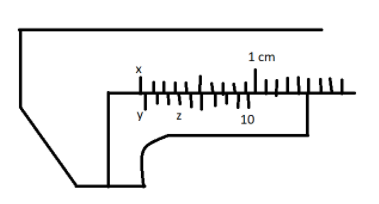
Find the zero error in the figure given.

A) $0.3mm$
B) $-0.3mm$
C) $-0.7mm$
D) $0.7mm$
Answer
216k+ views
Hint: Zero error is defined as the state under which a measurement tool reports a read where no reading is to occur. When vernier callipers do not balance a zero in the main scale with a zero in the vernier scale. There can be two forms of zero error: if the scale is more than zero it is positive; otherwise it is negative. Using the formulation: real read = main scale $ + $ vernier scale $ - $ (zero error). The way of using a vernier scale or calliper is to use the formula.
Complete step by step solution:
As the vernier scale zero is ahead of the main scale zero. Thus, the error is zero positive.
Least count of the vernier calliper \[L.C. = 0.1\; mm\]
Since the third division matches with the main scale division.
Zero error is \[n \times L.C. = 3 \times 0.1 = 0.3\; mm\].
Note: The vernier scale is a visual aid to compare accurately between two linear graduation marks by means of mechanical interpolation; this increases the resolution and the ambiguity of estimation by using vernier acuity to reduce the error of the human approximation.
The vernier is a secondary scale that replaces a single indicator and has ten divisions on the main scale, for instance, which are equal in distance to nine divisions. Interpolated readings can be achieved by looking at which vernier measures are coincidental with the main scale graduation, which is much easier to interpret than the two-point visual estimate. Such a solution can be achieved with a higher resolution, known as the vernier constant. In circular or straight scales, a vernier may be used if the linear system is appropriate.
Complete step by step solution:
As the vernier scale zero is ahead of the main scale zero. Thus, the error is zero positive.
Least count of the vernier calliper \[L.C. = 0.1\; mm\]
Since the third division matches with the main scale division.
Zero error is \[n \times L.C. = 3 \times 0.1 = 0.3\; mm\].
Note: The vernier scale is a visual aid to compare accurately between two linear graduation marks by means of mechanical interpolation; this increases the resolution and the ambiguity of estimation by using vernier acuity to reduce the error of the human approximation.
The vernier is a secondary scale that replaces a single indicator and has ten divisions on the main scale, for instance, which are equal in distance to nine divisions. Interpolated readings can be achieved by looking at which vernier measures are coincidental with the main scale graduation, which is much easier to interpret than the two-point visual estimate. Such a solution can be achieved with a higher resolution, known as the vernier constant. In circular or straight scales, a vernier may be used if the linear system is appropriate.
Recently Updated Pages
JEE Atomic Structure and Chemical Bonding important Concepts and Tips

JEE Amino Acids and Peptides Important Concepts and Tips for Exam Preparation

Electricity and Magnetism Explained: Key Concepts & Applications

Chemical Properties of Hydrogen - Important Concepts for JEE Exam Preparation

JEE Energetics Important Concepts and Tips for Exam Preparation

JEE Isolation, Preparation and Properties of Non-metals Important Concepts and Tips for Exam Preparation

Trending doubts
JEE Main 2026: Application Form Open, Exam Dates, Syllabus, Eligibility & Question Papers

Derivation of Equation of Trajectory Explained for Students

Hybridisation in Chemistry – Concept, Types & Applications

Understanding the Angle of Deviation in a Prism

Understanding Collisions: Types and Examples for Students

How to Convert a Galvanometer into an Ammeter or Voltmeter

Other Pages
JEE Advanced Marks vs Ranks 2025: Understanding Category-wise Qualifying Marks and Previous Year Cut-offs

Units And Measurements Class 11 Physics Chapter 1 CBSE Notes - 2025-26

NCERT Solutions For Class 11 Physics Chapter 8 Mechanical Properties Of Solids

Motion in a Straight Line Class 11 Physics Chapter 2 CBSE Notes - 2025-26

NCERT Solutions for Class 11 Physics Chapter 7 Gravitation 2025-26

Ideal and Non-Ideal Solutions Explained for Class 12 Chemistry




